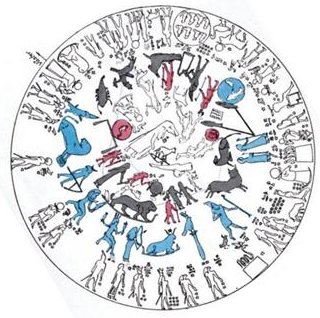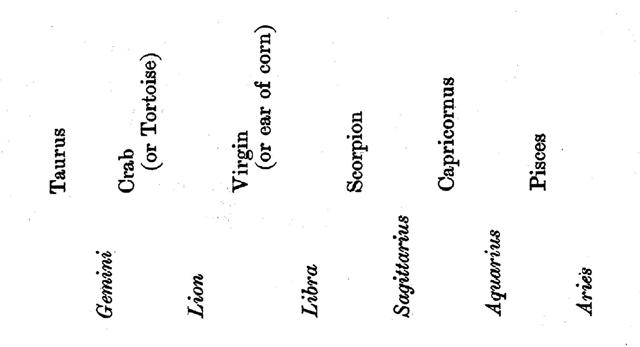|
The Golden Age is used in Hamlet's Mill for the time when Gemini marked spring equinox and Virgo stood at midsummer. Pisces was at winter solstice and Sagittarius at autumn equinox (maybe shooting his 'arrow' into the close by 'water surface' to produce a new 'fire' - the old Sun had just left). The perching blue bird on his pillar would like Gemini have been at spring equinox, and at midsummer we maybe should find the seated blue 'eastern bank of the Nile', the waxing Moon (front side) of Anuket.
But the constellations could have been different. Jensen thought so and below I quote him via Lockyer:
Chnemu (Khnum) is useful for us, because he is here stated to be equivalent with Capricorn (the Goat-Fish), and he will then (appropriately) be number 1 among the blackmarked signs of Dendera. But if Pisces at that time was at winter solstice, then Capricorn (Khnum) would be located a doublemonth earlier, in the dark time when people were waiting for the new year to arrive. Which in a way agrees with how I have interpreted the blue Khnum with his 'digging stick' in the Dendera zodiac, down in the earth there is no light. Maybe the blue zodiac has been compressed and the blue Khnum has a position 3 months earlier than the blue 'hippotamus Pisces' - thought of as positioned at winter solstice, as in the Golden Age. The absence of blue signs in the interval Scorpio - Aquarius could illustrate a 'crack in time' through which the current age breaks forth (according to path of the Sun which moves with the precession). From Tama to the front side of the G text there are 3 months. The Tortoise (number 7 counted from the Goat-Fish) has been put equal to Cancer, also a valuable item for us. Counting with only 6 signs the Tortoise will be number 3, i.e. on the other side of the sky compared with the Goat-Fish. Now to Hamlet's Mill: "Men's spirits were thought to dwell in the Milky Way between incarnations. This conception has been handed down as an Orphic and Pythagorean tradition fitting into the frame of the migration of the soul. Macrobius, who has provided the broadest report on the matter, has it that souls ascend by way of Capricorn, and then, in order to be reborn, descend again through the 'Gate of Cancer'. The Goat-Fish, I guess, has a fish tail in order to illustrate the movement up from the water into the branches of the tree of cosmos. And Cancer, we have just concluded is opposite to the Goat-Fish. Macrobius talks of signs; the constellations rising at the solstices in his time (and still in ours) were Gemini and Sagittarius: the 'Gate of Cancer' means Gemini. In fact, he states explicitly (I,12.5) that this 'Gate' is 'where the Zodiac and the Milky Way intersect'. Far away, the Mangaians of old (Austral Islands, Polynesia), who kept the precessional clock running instead of switching over to 'signs', claim that only at the evening of the solstitial days can spirits enter heaven, the inhabitants of the northern parts of the island at one solstice, the dwellers in the south at the other ... Considering the fact that the crossroads of ecliptic and Galaxy are crisis-resistant, that is, not concerned with the Precession, the reader may want to know why the Mangaians thought they could go to heaven only on the two solstitial days. Because, in order to 'change trains' comfortably, the constellations that serve as 'gates' to the Milky Way must 'stand' upon the 'earth', meaning that they must rise heliacally either at the equinoxes or at the solstices. The Galaxy is a very broad highway, but even so there must have been some bitter millenia when neither gate was directly available any longer, the one hanging in midair, the other having turned into a submarine entrance ..." |

